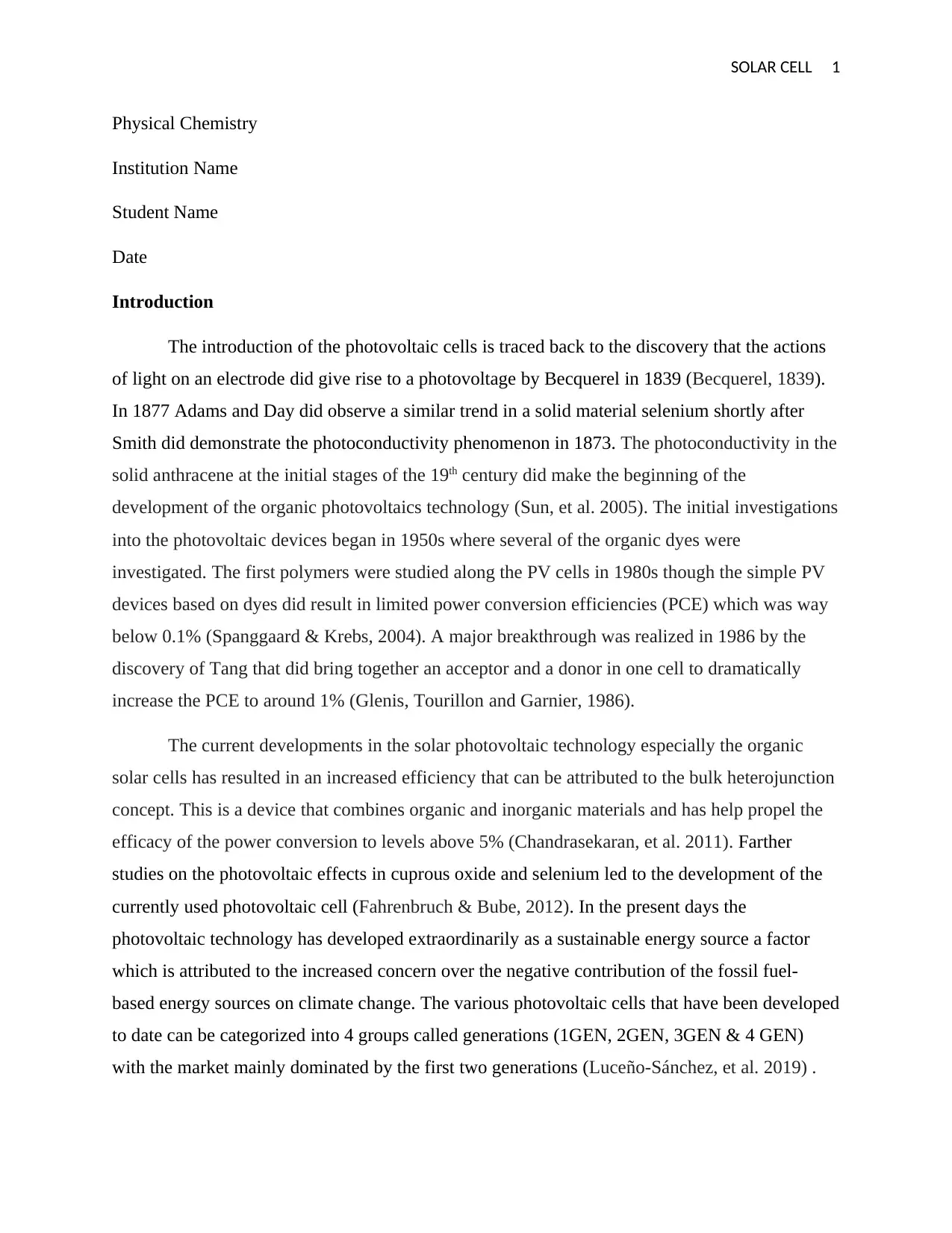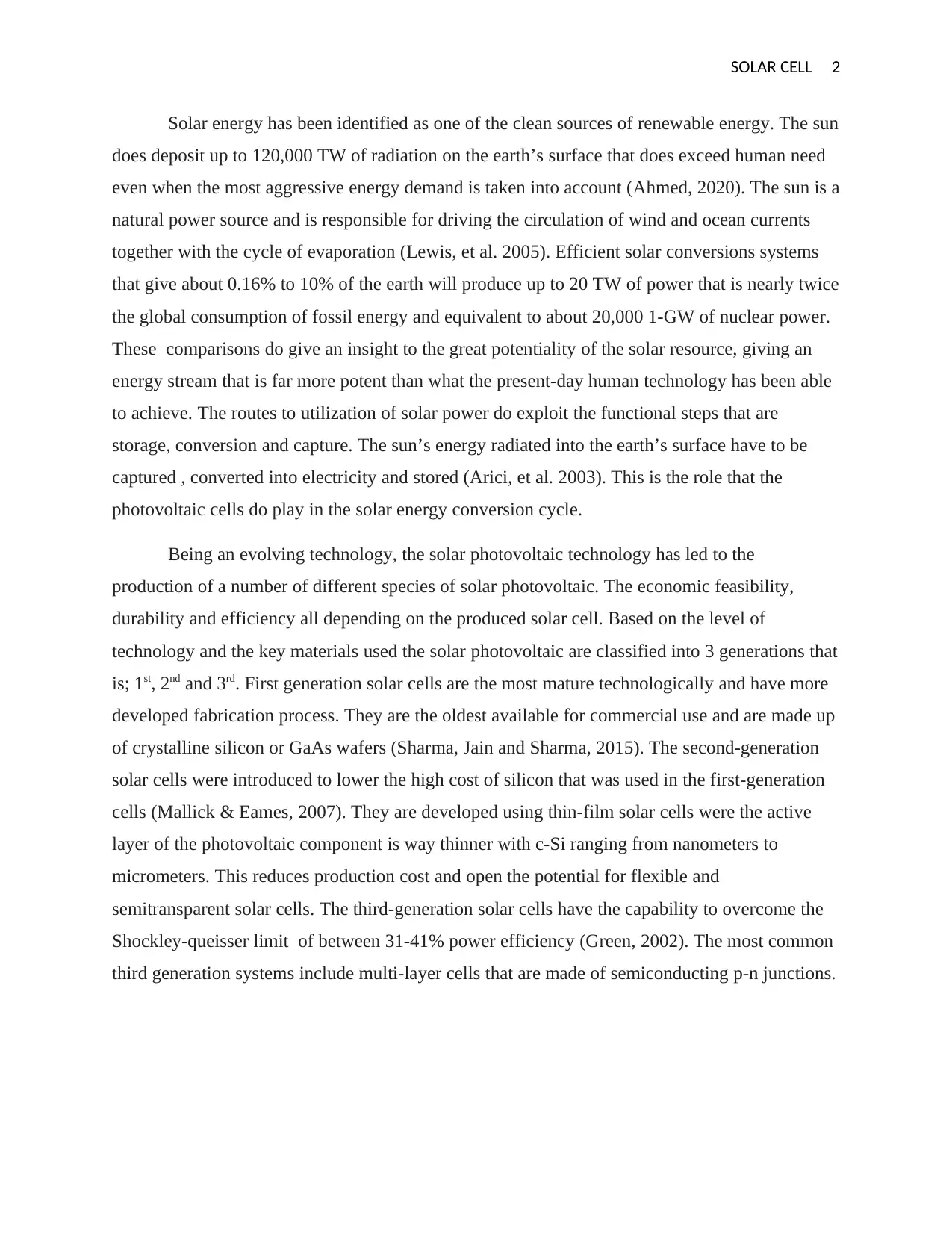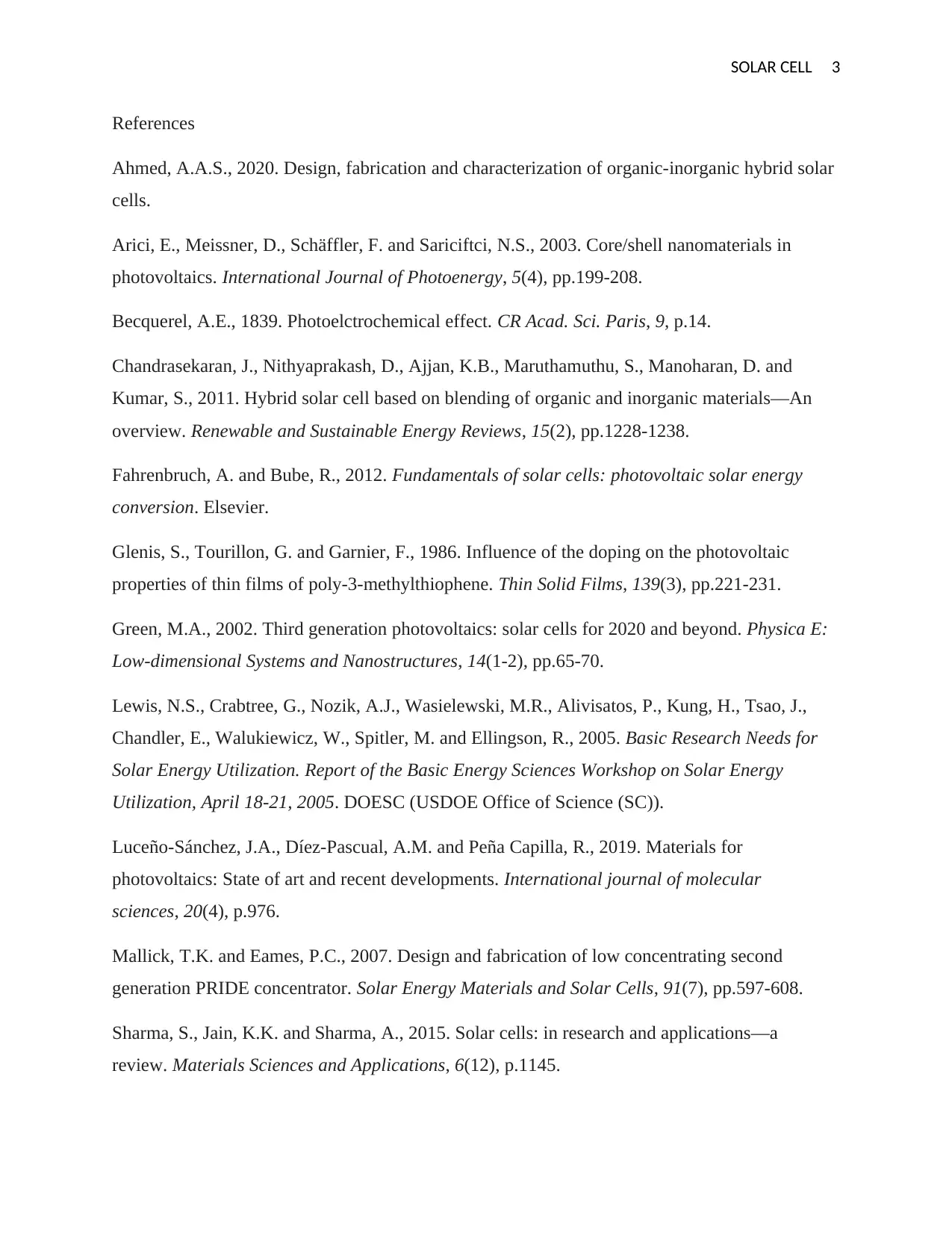Solar Cell: Generations, Materials, and Efficiency Report
VerifiedAdded on 2022/09/12
|4
|1327
|26
Report
AI Summary
This report provides a comprehensive overview of solar cell technology, tracing its development from the early discoveries of the photovoltaic effect to the current advancements in organic and hybrid solar cells. It categorizes solar cells into four generations, detailing the materials and fabrication processes of each, including crystalline silicon, thin-film technologies, and novel materials. The report highlights the increasing efficiency of organic solar cells due to the bulk heterojunction concept, emphasizing the role of hybrid solar cells that combine organic and inorganic materials. It also discusses the potential of solar energy as a sustainable energy source, its efficiency, and its capacity to meet global energy demands, emphasizing the importance of solar energy conversion. The report references key publications and research in the field, including the work of Becquerel, Adams and Day, Tang, and others, providing a detailed analysis of the history, current state, and future prospects of solar photovoltaic technology.

SOLAR CELL 1
Physical Chemistry
Institution Name
Student Name
Date
Introduction
The introduction of the photovoltaic cells is traced back to the discovery that the actions
of light on an electrode did give rise to a photovoltage by Becquerel in 1839 (Becquerel, 1839).
In 1877 Adams and Day did observe a similar trend in a solid material selenium shortly after
Smith did demonstrate the photoconductivity phenomenon in 1873. The photoconductivity in the
solid anthracene at the initial stages of the 19th century did make the beginning of the
development of the organic photovoltaics technology (Sun, et al. 2005). The initial investigations
into the photovoltaic devices began in 1950s where several of the organic dyes were
investigated. The first polymers were studied along the PV cells in 1980s though the simple PV
devices based on dyes did result in limited power conversion efficiencies (PCE) which was way
below 0.1% (Spanggaard & Krebs, 2004). A major breakthrough was realized in 1986 by the
discovery of Tang that did bring together an acceptor and a donor in one cell to dramatically
increase the PCE to around 1% (Glenis, Tourillon and Garnier, 1986).
The current developments in the solar photovoltaic technology especially the organic
solar cells has resulted in an increased efficiency that can be attributed to the bulk heterojunction
concept. This is a device that combines organic and inorganic materials and has help propel the
efficacy of the power conversion to levels above 5% (Chandrasekaran, et al. 2011). Farther
studies on the photovoltaic effects in cuprous oxide and selenium led to the development of the
currently used photovoltaic cell (Fahrenbruch & Bube, 2012). In the present days the
photovoltaic technology has developed extraordinarily as a sustainable energy source a factor
which is attributed to the increased concern over the negative contribution of the fossil fuel-
based energy sources on climate change. The various photovoltaic cells that have been developed
to date can be categorized into 4 groups called generations (1GEN, 2GEN, 3GEN & 4 GEN)
with the market mainly dominated by the first two generations (Luceño-Sánchez, et al. 2019) .
Physical Chemistry
Institution Name
Student Name
Date
Introduction
The introduction of the photovoltaic cells is traced back to the discovery that the actions
of light on an electrode did give rise to a photovoltage by Becquerel in 1839 (Becquerel, 1839).
In 1877 Adams and Day did observe a similar trend in a solid material selenium shortly after
Smith did demonstrate the photoconductivity phenomenon in 1873. The photoconductivity in the
solid anthracene at the initial stages of the 19th century did make the beginning of the
development of the organic photovoltaics technology (Sun, et al. 2005). The initial investigations
into the photovoltaic devices began in 1950s where several of the organic dyes were
investigated. The first polymers were studied along the PV cells in 1980s though the simple PV
devices based on dyes did result in limited power conversion efficiencies (PCE) which was way
below 0.1% (Spanggaard & Krebs, 2004). A major breakthrough was realized in 1986 by the
discovery of Tang that did bring together an acceptor and a donor in one cell to dramatically
increase the PCE to around 1% (Glenis, Tourillon and Garnier, 1986).
The current developments in the solar photovoltaic technology especially the organic
solar cells has resulted in an increased efficiency that can be attributed to the bulk heterojunction
concept. This is a device that combines organic and inorganic materials and has help propel the
efficacy of the power conversion to levels above 5% (Chandrasekaran, et al. 2011). Farther
studies on the photovoltaic effects in cuprous oxide and selenium led to the development of the
currently used photovoltaic cell (Fahrenbruch & Bube, 2012). In the present days the
photovoltaic technology has developed extraordinarily as a sustainable energy source a factor
which is attributed to the increased concern over the negative contribution of the fossil fuel-
based energy sources on climate change. The various photovoltaic cells that have been developed
to date can be categorized into 4 groups called generations (1GEN, 2GEN, 3GEN & 4 GEN)
with the market mainly dominated by the first two generations (Luceño-Sánchez, et al. 2019) .
Paraphrase This Document
Need a fresh take? Get an instant paraphrase of this document with our AI Paraphraser

SOLAR CELL 2
Solar energy has been identified as one of the clean sources of renewable energy. The sun
does deposit up to 120,000 TW of radiation on the earth’s surface that does exceed human need
even when the most aggressive energy demand is taken into account (Ahmed, 2020). The sun is a
natural power source and is responsible for driving the circulation of wind and ocean currents
together with the cycle of evaporation (Lewis, et al. 2005). Efficient solar conversions systems
that give about 0.16% to 10% of the earth will produce up to 20 TW of power that is nearly twice
the global consumption of fossil energy and equivalent to about 20,000 1-GW of nuclear power.
These comparisons do give an insight to the great potentiality of the solar resource, giving an
energy stream that is far more potent than what the present-day human technology has been able
to achieve. The routes to utilization of solar power do exploit the functional steps that are
storage, conversion and capture. The sun’s energy radiated into the earth’s surface have to be
captured , converted into electricity and stored (Arici, et al. 2003). This is the role that the
photovoltaic cells do play in the solar energy conversion cycle.
Being an evolving technology, the solar photovoltaic technology has led to the
production of a number of different species of solar photovoltaic. The economic feasibility,
durability and efficiency all depending on the produced solar cell. Based on the level of
technology and the key materials used the solar photovoltaic are classified into 3 generations that
is; 1st, 2nd and 3rd. First generation solar cells are the most mature technologically and have more
developed fabrication process. They are the oldest available for commercial use and are made up
of crystalline silicon or GaAs wafers (Sharma, Jain and Sharma, 2015). The second-generation
solar cells were introduced to lower the high cost of silicon that was used in the first-generation
cells (Mallick & Eames, 2007). They are developed using thin-film solar cells were the active
layer of the photovoltaic component is way thinner with c-Si ranging from nanometers to
micrometers. This reduces production cost and open the potential for flexible and
semitransparent solar cells. The third-generation solar cells have the capability to overcome the
Shockley-queisser limit of between 31-41% power efficiency (Green, 2002). The most common
third generation systems include multi-layer cells that are made of semiconducting p-n junctions.
Solar energy has been identified as one of the clean sources of renewable energy. The sun
does deposit up to 120,000 TW of radiation on the earth’s surface that does exceed human need
even when the most aggressive energy demand is taken into account (Ahmed, 2020). The sun is a
natural power source and is responsible for driving the circulation of wind and ocean currents
together with the cycle of evaporation (Lewis, et al. 2005). Efficient solar conversions systems
that give about 0.16% to 10% of the earth will produce up to 20 TW of power that is nearly twice
the global consumption of fossil energy and equivalent to about 20,000 1-GW of nuclear power.
These comparisons do give an insight to the great potentiality of the solar resource, giving an
energy stream that is far more potent than what the present-day human technology has been able
to achieve. The routes to utilization of solar power do exploit the functional steps that are
storage, conversion and capture. The sun’s energy radiated into the earth’s surface have to be
captured , converted into electricity and stored (Arici, et al. 2003). This is the role that the
photovoltaic cells do play in the solar energy conversion cycle.
Being an evolving technology, the solar photovoltaic technology has led to the
production of a number of different species of solar photovoltaic. The economic feasibility,
durability and efficiency all depending on the produced solar cell. Based on the level of
technology and the key materials used the solar photovoltaic are classified into 3 generations that
is; 1st, 2nd and 3rd. First generation solar cells are the most mature technologically and have more
developed fabrication process. They are the oldest available for commercial use and are made up
of crystalline silicon or GaAs wafers (Sharma, Jain and Sharma, 2015). The second-generation
solar cells were introduced to lower the high cost of silicon that was used in the first-generation
cells (Mallick & Eames, 2007). They are developed using thin-film solar cells were the active
layer of the photovoltaic component is way thinner with c-Si ranging from nanometers to
micrometers. This reduces production cost and open the potential for flexible and
semitransparent solar cells. The third-generation solar cells have the capability to overcome the
Shockley-queisser limit of between 31-41% power efficiency (Green, 2002). The most common
third generation systems include multi-layer cells that are made of semiconducting p-n junctions.

SOLAR CELL 3
References
Ahmed, A.A.S., 2020. Design, fabrication and characterization of organic-inorganic hybrid solar
cells.
Arici, E., Meissner, D., Schäffler, F. and Sariciftci, N.S., 2003. Core/shell nanomaterials in
photovoltaics. International Journal of Photoenergy, 5(4), pp.199-208.
Becquerel, A.E., 1839. Photoelctrochemical effect. CR Acad. Sci. Paris, 9, p.14.
Chandrasekaran, J., Nithyaprakash, D., Ajjan, K.B., Maruthamuthu, S., Manoharan, D. and
Kumar, S., 2011. Hybrid solar cell based on blending of organic and inorganic materials—An
overview. Renewable and Sustainable Energy Reviews, 15(2), pp.1228-1238.
Fahrenbruch, A. and Bube, R., 2012. Fundamentals of solar cells: photovoltaic solar energy
conversion. Elsevier.
Glenis, S., Tourillon, G. and Garnier, F., 1986. Influence of the doping on the photovoltaic
properties of thin films of poly-3-methylthiophene. Thin Solid Films, 139(3), pp.221-231.
Green, M.A., 2002. Third generation photovoltaics: solar cells for 2020 and beyond. Physica E:
Low-dimensional Systems and Nanostructures, 14(1-2), pp.65-70.
Lewis, N.S., Crabtree, G., Nozik, A.J., Wasielewski, M.R., Alivisatos, P., Kung, H., Tsao, J.,
Chandler, E., Walukiewicz, W., Spitler, M. and Ellingson, R., 2005. Basic Research Needs for
Solar Energy Utilization. Report of the Basic Energy Sciences Workshop on Solar Energy
Utilization, April 18-21, 2005. DOESC (USDOE Office of Science (SC)).
Luceño-Sánchez, J.A., Díez-Pascual, A.M. and Peña Capilla, R., 2019. Materials for
photovoltaics: State of art and recent developments. International journal of molecular
sciences, 20(4), p.976.
Mallick, T.K. and Eames, P.C., 2007. Design and fabrication of low concentrating second
generation PRIDE concentrator. Solar Energy Materials and Solar Cells, 91(7), pp.597-608.
Sharma, S., Jain, K.K. and Sharma, A., 2015. Solar cells: in research and applications—a
review. Materials Sciences and Applications, 6(12), p.1145.
References
Ahmed, A.A.S., 2020. Design, fabrication and characterization of organic-inorganic hybrid solar
cells.
Arici, E., Meissner, D., Schäffler, F. and Sariciftci, N.S., 2003. Core/shell nanomaterials in
photovoltaics. International Journal of Photoenergy, 5(4), pp.199-208.
Becquerel, A.E., 1839. Photoelctrochemical effect. CR Acad. Sci. Paris, 9, p.14.
Chandrasekaran, J., Nithyaprakash, D., Ajjan, K.B., Maruthamuthu, S., Manoharan, D. and
Kumar, S., 2011. Hybrid solar cell based on blending of organic and inorganic materials—An
overview. Renewable and Sustainable Energy Reviews, 15(2), pp.1228-1238.
Fahrenbruch, A. and Bube, R., 2012. Fundamentals of solar cells: photovoltaic solar energy
conversion. Elsevier.
Glenis, S., Tourillon, G. and Garnier, F., 1986. Influence of the doping on the photovoltaic
properties of thin films of poly-3-methylthiophene. Thin Solid Films, 139(3), pp.221-231.
Green, M.A., 2002. Third generation photovoltaics: solar cells for 2020 and beyond. Physica E:
Low-dimensional Systems and Nanostructures, 14(1-2), pp.65-70.
Lewis, N.S., Crabtree, G., Nozik, A.J., Wasielewski, M.R., Alivisatos, P., Kung, H., Tsao, J.,
Chandler, E., Walukiewicz, W., Spitler, M. and Ellingson, R., 2005. Basic Research Needs for
Solar Energy Utilization. Report of the Basic Energy Sciences Workshop on Solar Energy
Utilization, April 18-21, 2005. DOESC (USDOE Office of Science (SC)).
Luceño-Sánchez, J.A., Díez-Pascual, A.M. and Peña Capilla, R., 2019. Materials for
photovoltaics: State of art and recent developments. International journal of molecular
sciences, 20(4), p.976.
Mallick, T.K. and Eames, P.C., 2007. Design and fabrication of low concentrating second
generation PRIDE concentrator. Solar Energy Materials and Solar Cells, 91(7), pp.597-608.
Sharma, S., Jain, K.K. and Sharma, A., 2015. Solar cells: in research and applications—a
review. Materials Sciences and Applications, 6(12), p.1145.
⊘ This is a preview!⊘
Do you want full access?
Subscribe today to unlock all pages.

Trusted by 1+ million students worldwide

SOLAR CELL 4
Spanggaard, H. and Krebs, F.C., 2004. A brief history of the development of organic and
polymeric photovoltaics. Solar Energy Materials and Solar Cells, 83(2-3), pp.125-146.
Sun, S., Fan, Z., Wang, Y. and Haliburton, J., 2005. Organic solar cell optimizations. Journal of
materials science, 40(6), pp.1429-1443.
Spanggaard, H. and Krebs, F.C., 2004. A brief history of the development of organic and
polymeric photovoltaics. Solar Energy Materials and Solar Cells, 83(2-3), pp.125-146.
Sun, S., Fan, Z., Wang, Y. and Haliburton, J., 2005. Organic solar cell optimizations. Journal of
materials science, 40(6), pp.1429-1443.
1 out of 4
Your All-in-One AI-Powered Toolkit for Academic Success.
+13062052269
info@desklib.com
Available 24*7 on WhatsApp / Email
![[object Object]](/_next/static/media/star-bottom.7253800d.svg)
Unlock your academic potential
Copyright © 2020–2025 A2Z Services. All Rights Reserved. Developed and managed by ZUCOL.
